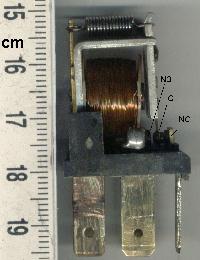
Electromechanics
In engineering, electromechanics[1][2][3][4] combines processes and procedures drawn from electrical engineering and mechanical engineering. Electromechanics focuses on the interaction of electrical and mechanical systems as a whole and how the two systems interact with each other. This process is especially prominent in systems such as those of DC or AC rotating electrical machines which can be designed and operated to generate power from a mechanical process (generator) or used to power a mechanical effect (motor). Electrical engineering in this context also encompasses electronics engineering.
"Electro-mechanical" redirects here. For the use of electromechanics in arcade games, see Electro-mechanical game.
Electromechanical devices are ones which have both electrical and mechanical processes. Strictly speaking, a manually operated switch is an electromechanical component due to the mechanical movement causing an electrical output. Though this is true, the term is usually understood to refer to devices which involve an electrical signal to create mechanical movement, or vice versa mechanical movement to create an electric signal. Often involving electromagnetic principles such as in relays, which allow a voltage or current to control another, usually isolated circuit voltage or current by mechanically switching sets of contacts, and solenoids, by which a voltage can actuate a moving linkage as in solenoid valves.
Before the development of modern electronics, electromechanical devices were widely used in complicated subsystems of parts, including electric typewriters, teleprinters, clocks, initial television systems, and the very early electromechanical digital computers. Solid-state electronics have replaced electromechanics in many applications.
Modern practice[edit]
Today, electromechanical processes are mainly used by power companies. All fuel based generators convert mechanical movement to electrical power. Some renewable energies such as wind and hydroelectric are powered by mechanical systems that also convert movement to electricity.
In the last thirty years of the 20th century, equipment which would generally have used electromechanical devices became less expensive. This equipment became cheaper because it used more reliably integrated microcontroller circuits containing ultimately a few million transistors, and a program to carry out the same task through logic. With electromechanical components there were only moving parts, such as mechanical electric actuators. This more reliable logic has replaced most electromechanical devices, because any point in a system which must rely on mechanical movement for proper operation will inevitably have mechanical wear and eventually fail. Properly designed electronic circuits without moving parts will continue to operate correctly almost indefinitely and are used in most simple feedback control systems. Circuits without moving parts appear in a large number of items from traffic lights to washing machines.
Another electromechanical device is Piezoelectric devices, but they do not use electromagnetic principles. Piezoelectric devices can create sound or vibration from an electrical signal or create an electrical signal from sound or mechanical vibration.
To become an electromechanical engineer, typical college courses involve mathematics, engineering, computer science, designing of machines, and other automotive classes that help gain skill in troubleshooting and analyzing issues with machines. To be an electromechanical engineer a bachelor's degree is required, usually in electrical, mechanical, or electromechanical engineering. As of April 2018, only two universities, Michigan Technological University and Wentworth Institute of Technology, offer the major of electromechanical engineering . To enter the electromechanical field as an entry level technician, an associative degree is all that is required.
As of 2016, approximately 13,800 people work as electro-mechanical technicians in the US. The job outlook for 2016 to 2026 for technicians is 4% growth which is about an employment change of 500 positions. This outlook is slower than average.[11]